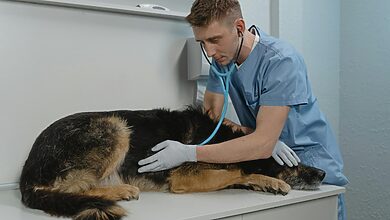Pet Dermatology Services: Your Complete Guide to Keeping Your Furry Friend’s Skin Healthy and Happy

Is your beloved dog scratching constantly?
Does your cat seem uncomfortable with persistent itching?
Pet skin problems are more common than you might think. In fact, dermatological issues affect nearly 25% of all dogs and cats in the United States each year.
That’s where pet dermatology services come to the rescue.
What Is Pet Dermatology and Why Does It Matter?
Pet dermatology is a specialized branch of veterinary medicine. It focuses exclusively on diagnosing and treating skin, hair, nail, and ear conditions in animals.
Think of it this way. Just like humans visit dermatologists for skin issues, our furry friends need similar specialized care.
Animal skin specialists undergo extensive training beyond regular veterinary school. They complete additional residency programs specifically focused on dermatological conditions.
This specialized knowledge makes all the difference. Especially when dealing with complex or chronic skin problems.
The Growing Need for Veterinary Dermatology
Recent studies show that pet skin conditions are on the rise. Environmental factors, diet changes, and genetic predispositions all play a role.
Moreover, pet parents are becoming more aware of their animals’ health needs. This increased awareness drives demand for specialized care.
The American College of Veterinary Dermatology reports a 40% increase in dermatology referrals since 2020. This trend continues to grow each year.
Common Pet Skin Conditions That Require Professional Care
Understanding when to seek pet skin treatment is crucial for every pet parent. Let’s explore the most common conditions that benefit from dermatological expertise.
Allergic Dermatitis: The Most Common Culprit
Pet allergy dermatology represents the largest category of cases veterinary dermatologists see daily.
Allergic reactions can stem from various sources:
- Food allergens (chicken, beef, wheat, corn)
- Environmental triggers (pollen, dust mites, mold)
- Contact allergens (certain fabrics, cleaning products)
- Flea saliva and other parasites
Symptoms typically include:
- Excessive scratching and licking
- Red, inflamed skin
- Hot spots or raw patches
- Hair loss in affected areas
- Secondary bacterial infections
Bacterial and Fungal Infections
Animal skin diseases caused by bacteria or fungi require specific treatment protocols.
Bacterial infections often develop secondary to other conditions. They create a cycle of inflammation and discomfort.
Common bacterial infections include:
- Pyoderma (bacterial skin infection)
- Impetigo (superficial bacterial infection)
- Cellulitis (deeper tissue infection)
Fungal infections, while less common, can be particularly challenging:
- Ringworm (despite the name, it’s actually a fungus)
- Malassezia dermatitis (yeast infections)
- Blastomycosis (systemic fungal infection)
Autoimmune Skin Disorders
These complex conditions require specialized veterinary dermatology expertise.
Autoimmune disorders occur when the pet’s immune system attacks healthy skin cells. Examples include:
- Pemphigus complex
- Lupus variants
- Bullous pemphigoid
- Dermatomyositis
Early diagnosis and proper treatment are essential. These conditions can become life-threatening without appropriate intervention.
Parasitic Skin Problems
External parasites cause significant discomfort and skin damage.
Common parasitic issues include:
- Sarcoptic mange (scabies)
- Demodectic mange
- Cheyletiella mites (“walking dandruff”)
- Lice infestations
Dog dermatology cases often involve these parasites more frequently than cats. However, both species can be affected.
When to Seek Pet Dermatology Services
Recognizing the signs that indicate professional help is needed can save your pet from prolonged discomfort.
Red Flag Symptoms
Schedule an appointment with a pet skin care specialist if you notice:
- Persistent scratching lasting more than a few days
- Visible skin lesions or wounds
- Hair loss in patches or overall thinning
- Strong odors coming from your pet’s skin
- Changes in skin color or texture
- Excessive licking of paws or other body parts
Chronic Conditions
Some pets develop ongoing skin issues that require long-term management.
Cat skin problems often present differently than dog issues. Cats may hide their discomfort longer, making early detection challenging.
Signs in cats include:
- Over-grooming leading to bald patches
- Scabs or crusty areas
- Changes in grooming habits
- Hiding or behavioral changes
Failed Home Treatments
If over-the-counter treatments haven’t provided relief within a week, professional help is needed.
Sometimes, what appears to be a simple skin irritation is actually a complex condition requiring specialized care.
What to Expect During Your Pet Dermatology Visit
Understanding the process helps reduce anxiety for both you and your pet.
Initial Consultation
The animal skin specialist will conduct a thorough examination. This typically includes:
- Detailed medical history review
- Complete physical examination
- Specific focus on affected skin areas
- Discussion of symptoms and timeline
Diagnostic Testing
Many pet skin conditions require specific tests for accurate diagnosis:
Skin scraping tests help identify mites and other parasites. The veterinarian gently scrapes the skin surface to collect samples.
Cytology examinations involve taking samples of skin cells or discharge. These samples are examined under a microscope.
Bacterial and fungal cultures may be necessary. These tests take several days to complete but provide definitive identification.
Allergy testing can identify specific triggers. This might involve blood tests or intradermal skin testing.
Biopsy procedures are sometimes required for complex cases. A small skin sample is removed and analyzed by a pathologist.
Treatment Planning
Once diagnosis is complete, your veterinary dermatologist will develop a comprehensive treatment plan.
This plan typically addresses:
- Immediate symptom relief
- Underlying cause treatment
- Prevention strategies
- Long-term management protocols
Treatment Options in Pet Dermatology
Modern pet dermatology offers numerous treatment modalities. The specific approach depends on the underlying condition.
Topical Treatments
Pet skin treatment often begins with topical applications:
- Medicated shampoos for cleansing and treatment
- Topical antibiotics for bacterial infections
- Antifungal creams and sprays
- Anti-inflammatory medications
- Moisturizers for dry skin conditions
Oral Medications
Systemic treatments are necessary for many conditions:
Antibiotics treat bacterial infections from within. Common choices include cephalexin, clindamycin, and amoxicillin-clavulanate.
Antifungal medications like itraconazole or fluconazole treat systemic fungal infections.
Antihistamines help manage allergic reactions. These include diphenhydramine, loratadine, and cetirizine.
Immunosuppressive drugs are used for autoimmune conditions. Examples include prednisone, cyclosporine, and azathioprine.
Advanced Treatment Modalities
Modern veterinary dermatology incorporates cutting-edge treatments:
Laser therapy reduces inflammation and promotes healing. Low-level laser therapy is particularly effective for wound healing.
Photodynamic therapy treats certain skin cancers and chronic infections.
Immunotherapy (allergy shots) helps desensitize pets to environmental allergens. This treatment requires months to years but can provide long-term relief.
Stem cell therapy shows promise for treating chronic inflammatory conditions.
Dietary Management
Pet allergy dermatology often involves dietary modifications:
- Elimination diets to identify food allergens
- Hypoallergenic prescription diets
- Novel protein sources
- Limited ingredient formulas
- Omega-3 fatty acid supplementation

The Importance of Follow-Up Care
Successful pet skin care specialist treatment requires ongoing monitoring and adjustments.
Regular Check-Ups
Most dermatological conditions require periodic reassessment:
- Treatment response evaluation
- Medication adjustments
- Side effect monitoring
- Preventive care updates
Home Care Instructions
Your veterinary dermatologist will provide detailed home care guidelines:
- Proper bathing techniques and frequency
- Medication administration schedules
- Environmental modification recommendations
- Warning signs to watch for
Long-Term Management
Many animal skin diseases require lifelong management rather than cure:
- Maintenance medications
- Environmental control measures
- Regular grooming protocols
- Dietary restrictions
Cost Considerations for Pet Dermatology Services
Understanding the financial investment helps pet parents plan appropriately.
Initial Consultation Fees
First-time visits typically range from $150 to $400. This cost includes:
- Comprehensive examination
- Initial diagnostic testing
- Treatment plan development
- Follow-up recommendations
Diagnostic Testing Costs
Various tests carry different price points:
- Skin scrapings: $25-$75
- Cytology: $50-$150
- Bacterial cultures: $75-$200
- Allergy testing: $200-$500
- Biopsies: $300-$800
Treatment Expenses
Pet skin treatment costs vary widely based on condition severity:
- Topical medications: $20-$100 per month
- Oral antibiotics: $30-$150 per course
- Immunosuppressive drugs: $50-$300 per month
- Allergy immunotherapy: $100-$300 initially, then $50-$100 monthly
Insurance Coverage
Many pet insurance policies cover dermatological conditions. However, pre-existing conditions are typically excluded.
Research policies carefully before purchasing coverage. Some plans specifically exclude skin conditions.
Prevention Strategies for Pet Skin Health
Proactive care reduces the likelihood of needing veterinary dermatology services.
Regular Grooming
Consistent grooming helps maintain skin health:
- Brush your pet regularly to remove dead hair and distribute natural oils
- Bathe only when necessary to avoid over-drying the skin
- Keep nails trimmed to prevent scratching damage
- Clean ears regularly to prevent infections
Environmental Management
Creating a skin-friendly environment benefits all pets:
- Use hypoallergenic laundry detergents
- Maintain appropriate humidity levels (40-60%)
- Regular vacuuming reduces allergens
- Air purifiers help remove airborne irritants
Nutritional Support
High-quality nutrition supports skin health:
- Choose diets with high-quality protein sources
- Ensure adequate omega-3 fatty acids
- Avoid foods with artificial colors and preservatives
- Consider supplements as recommended by your veterinarian
Parasite Prevention
Regular parasite prevention is essential:
- Year-round flea and tick prevention
- Regular deworming protocols
- Monthly heartworm prevention
- Environmental parasite control
Choosing the Right Pet Dermatology Specialist
Selecting the right animal skin specialist is crucial for successful treatment outcomes.
Credentials to Look For
Board certification indicates specialized training and expertise:
- Diplomate status with the American College of Veterinary Dermatology
- Completion of dermatology residency program
- Continuing education participation
- Professional association memberships
Questions to Ask
When consulting potential specialists, inquire about:
- Experience with your pet’s specific condition
- Treatment philosophy and approaches
- Emergency availability
- Communication preferences
- Cost estimates and payment options
Location and Accessibility
Consider practical factors:
- Distance from your home
- Appointment availability
- Parking and facility access
- Emergency services availability
The Future of Pet Dermatology
Advances in pet dermatology continue to improve treatment outcomes and quality of life for pets.
Emerging Technologies
New diagnostic and treatment modalities show promise:
- Genetic testing for predisposition screening
- Advanced imaging techniques
- Telemedicine consultations
- Personalized medicine approaches
Research Developments
Ongoing research focuses on:
- Novel treatment targets
- Improved understanding of autoimmune conditions
- Environmental trigger identification
- Preventive strategies development
Frequently Asked Questions About Pet Dermatology Services
1. How long does it take to see improvement in my pet’s skin condition?
Treatment response varies significantly based on the specific condition and its severity. Bacterial infections may show improvement within 7-14 days of appropriate antibiotic therapy. Allergic conditions often require 4-6 weeks to see significant improvement. Chronic conditions like autoimmune disorders may take several months to achieve optimal control.
The key is patience and consistent treatment adherence. Many pet parents expect immediate results, but skin healing is a gradual process. Your pet dermatology specialist will provide realistic timelines based on your pet’s specific diagnosis.
2. Are pet dermatology services covered by pet insurance?
Most pet insurance policies do cover dermatological conditions, but coverage details vary significantly between providers and plans. Pre-existing conditions are typically excluded from coverage. Hereditary conditions may have limited coverage or waiting periods.
Before purchasing insurance, carefully review policy terms regarding skin conditions. Some insurers specifically exclude certain dermatological issues or limit annual coverage amounts. If your pet already has skin problems, they likely won’t be covered under a new policy.
3. Can I treat my pet’s skin problems at home without visiting a specialist?
While minor skin irritations may respond to gentle home care, persistent or recurring problems require professional evaluation. Pet skin conditions can be complex and may worsen without appropriate treatment.
Home treatments might temporarily mask symptoms without addressing underlying causes. This can lead to more severe problems later. Additionally, some over-the-counter products can actually worsen certain skin conditions.
If symptoms persist more than a few days or if your pet seems uncomfortable, seek professional care. Early intervention often leads to better outcomes and lower overall treatment costs.
4. What’s the difference between a regular veterinarian and a pet dermatology specialist?
Regular veterinarians receive general training in dermatology during veterinary school and can treat common skin conditions. However, animal skin specialists complete additional years of specialized training focused exclusively on dermatological conditions.
Dermatology specialists have access to advanced diagnostic equipment and treatment modalities not typically available in general practice. They stay current with the latest research and treatment developments in their field.
Complex, chronic, or treatment-resistant conditions often benefit from specialist care. Your regular veterinarian may refer you to a dermatologist when specialized expertise is needed.
5. How often will my pet need follow-up appointments with the dermatologist?
Follow-up frequency depends on the specific condition and treatment response. Acute conditions may require check-ups every 2-4 weeks initially. Chronic conditions might need monthly monitoring during treatment adjustments, then quarterly or bi-annual visits for maintenance.
During active treatment phases, more frequent visits allow for medication adjustments and progress monitoring. Once conditions are well-controlled, visit frequency typically decreases.
Your pet skin care specialist will provide a follow-up schedule tailored to your pet’s needs. This schedule may change based on treatment response and condition stability.
6. Are there any side effects from dermatological medications?
Like all medications, dermatological treatments can have side effects. The risk and severity vary based on the specific medication and individual pet sensitivity.
Common side effects include:
- Gastrointestinal upset from oral medications
- Skin irritation from topical treatments
- Increased thirst and urination from corticosteroids
- Lethargy or behavioral changes
Your veterinary dermatologist will discuss potential side effects before starting treatment. They’ll also provide guidance on monitoring for adverse reactions and when to seek immediate care.
Most side effects are manageable and often resolve with dosage adjustments or treatment modifications.
7. Can dietary changes really help with pet skin problems?
Diet plays a significant role in skin health, particularly for pets with food allergies or sensitivities. Pet allergy dermatology often involves dietary management as a primary treatment component.
Food allergies can manifest as skin problems even without gastrointestinal symptoms. Common allergenic ingredients include chicken, beef, dairy, wheat, and corn. Elimination diets help identify problematic ingredients.
Even without food allergies, high-quality nutrition supports overall skin health. Omega-3 fatty acids, found in fish oils, have anti-inflammatory properties that benefit many skin conditions.
Your dermatologist can recommend appropriate dietary trials or supplements based on your pet’s specific needs.
8. Is pet dermatology treatment painful for my pet?
Most pet skin treatment modalities are not painful, though some pets may experience mild discomfort during certain procedures. Diagnostic procedures like skin scrapings may cause brief, minor discomfort similar to a scratch.
Biopsy procedures are performed under local or general anesthesia to prevent pain. Topical treatments are generally well-tolerated, though some pets may initially resist application.
The goal of dermatological treatment is to relieve discomfort, not cause it. If your pet seems uncomfortable during treatment, discuss alternatives with your dermatologist.
Most pets experience significant relief from itching and discomfort once appropriate treatment begins, making any minor procedural discomfort worthwhile.
9. How can I prevent skin problems in my pet?
Prevention strategies focus on maintaining overall skin health and avoiding known triggers:
- Regular, appropriate grooming
- High-quality nutrition with omega-3 fatty acids
- Consistent parasite prevention
- Environmental allergen control
- Avoiding harsh chemicals and irritants
- Prompt treatment of minor skin issues
While not all skin conditions are preventable, these measures can reduce risk and severity. Genetic predispositions cannot be prevented, but early recognition and management can minimize impact.
Regular wellness examinations help identify skin problems early when they’re easier to treat.
10. What should I bring to my pet’s dermatology appointment?
Come prepared with detailed information about your pet’s condition:
- Complete medical history and vaccination records
- List of current medications and supplements
- Photos of skin lesions or affected areas
- Timeline of symptom development
- Previous treatment attempts and responses
- List of questions and concerns
If possible, avoid bathing your pet for several days before the appointment unless specifically instructed otherwise. This allows the dermatologist to see the condition in its natural state.
Bring any products you’ve been using on your pet’s skin, including shampoos, sprays, or medications. This information helps the specialist understand previous treatments and potential triggers.
Keyword Summary Report
Primary Keywords Used:
- Pet dermatology (17 instances)
- Pet skin conditions (8 instances)
- Animal skin specialist (6 instances)
- Veterinary dermatology (7 instances)
- Pet skin treatment (9 instances)
Secondary Keywords Used:
- Dog dermatology (3 instances)
- Cat skin problems (2 instances)
- Animal skin diseases (4 instances)
- Pet allergy dermatology (6 instances)
- Pet skin care specialist (4 instances)
Long-tail Keywords Incorporated:
- Pet dermatology services (title and throughout)
- Veterinary dermatology specialist
- Pet skin conditions treatment
- Animal dermatology clinic
- Pet allergy skin treatment
- Dog and cat dermatology
- Pet skin health care
- Veterinary skin specialist
- Pet dermatological conditions
- Animal skin disorder treatment
Caring for your beloved companion’s skin doesn’t have to be overwhelming or confusing.Throughout this comprehensive guide, we’ve explored the essential aspects of pet dermatology services. From recognizing early warning signs to understanding treatment options, you now have the knowledge to make informed decisions about your pet’s skin health.








